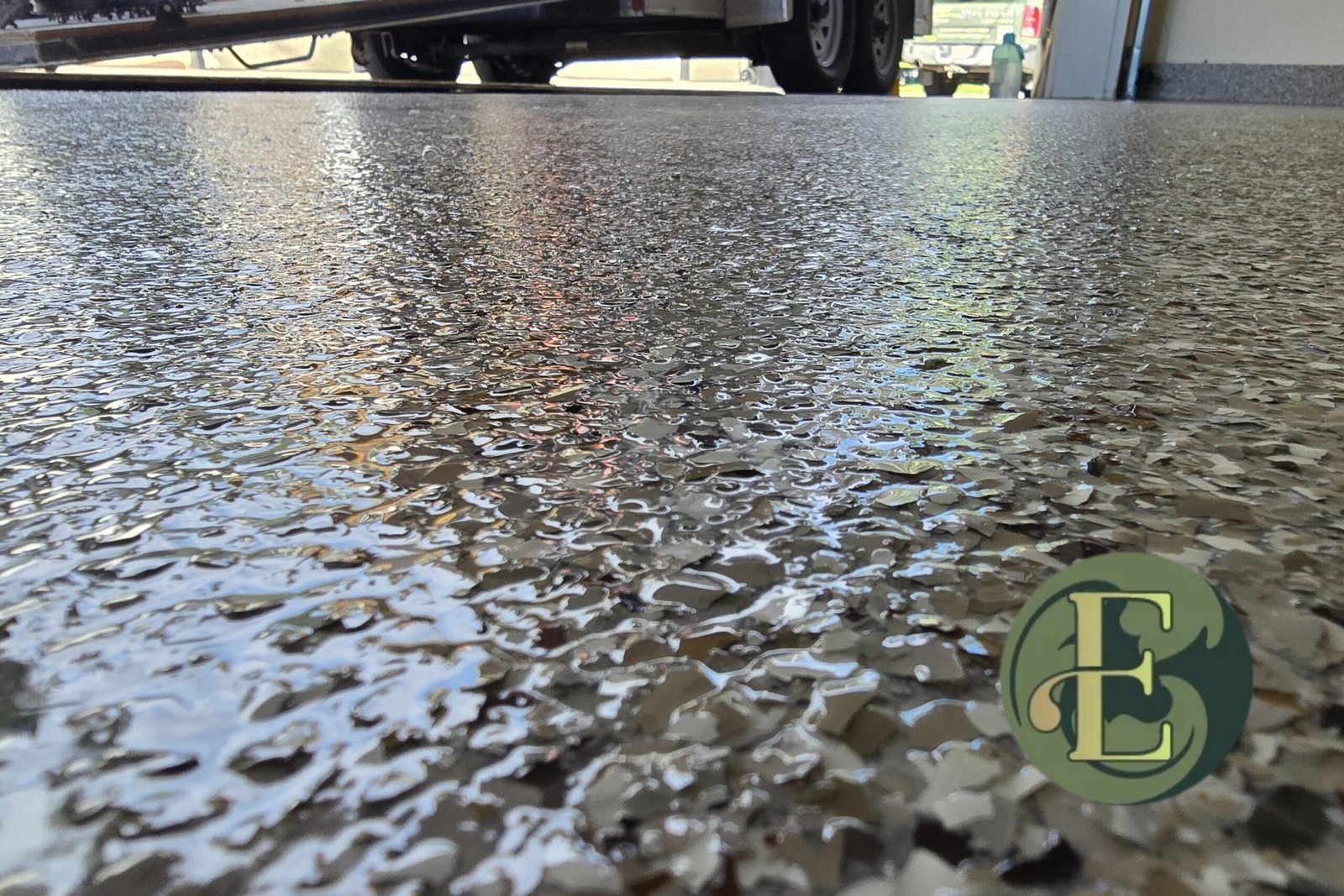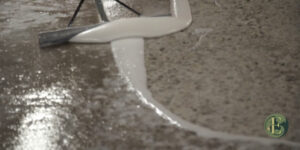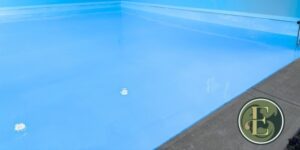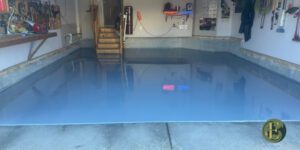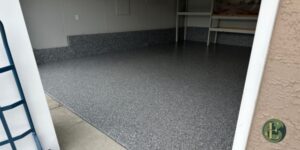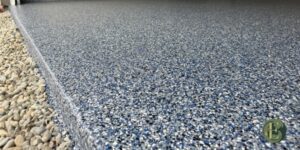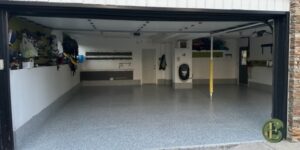At Elegant Coatings, we understand that epoxy flooring moisture represents the silent destroyer of the installation process, capable of compromising even the most meticulously planned installations.
Research indicates that moisture-related failures account for approximately 75% of all epoxy flooring performance issues1, making moisture management a critical consideration for both contractors and homeowners.
Understanding Moisture’s Impact
Concrete is inherently porous, acting like a massive sponge that can retain significant moisture levels. In Vancouver’s unique climate, concrete’s inherent porosity becomes an even more critical challenge for flooring systems. Research from the National Research Council of Canada highlights that concrete acts like a massive moisture-retaining sponge, with pore structures significantly impacting material performance.
Local studies reveal that:
- Moisture levels above 6% can compromise structural integrity
- Concrete’s pore characteristics directly influence water retention capabilities
- Vancouver’s high-humidity environment can accelerate moisture-related degradation
The National Research Council’s investigations demonstrate that concrete’s pore structure is not uniform, with interlayer spaces capable of retaining substantial moisture. In the Vancouver region, where humidity levels fluctuate dramatically, these moisture retention properties can pose significant risks to epoxy flooring installations.
Specific findings from Canadian research indicate that:
- Pore sizes ranging from 8 micrometers can dramatically affect material durability
- Water absorption can vary significantly based on concrete mix composition
- Supplementary cementitious materials can influence moisture penetration rates
These insights underscore the critical importance of comprehensive moisture management strategies, particularly in moisture-prone environments like Vancouver’s coastal climate.
Advanced Epoxy Flooring Moisture Testing Techniques
Calcium Chloride Test
This method quantifies moisture vapor emission rates using a standardized scientific approach. By placing a pre-weighed calcium chloride container on the concrete surface for 60-72 hours, professionals can:
- Measure moisture vapor emission in pounds per 1,000 sq. ft.
- Determine surface-level moisture characteristics
- Follow ASTM F1869 standardized testing protocols
Relative Humidity Probe Testing
Unlike surface-level assessments, this technique provides comprehensive internal moisture analysis. By inserting specialized sensors directly into the concrete, professionals can:
- Measure core concrete humidity levels
- Obtain precise relative humidity readings
- Utilize ASTM F2170 testing standards
- Evaluate long-term moisture potential within the concrete structure
Key Differences:
- Calcium Chloride Test: Surface-level moisture measurement
- Relative Humidity Probe: Internal moisture comprehensive analysis
Both methods are complementary, offering a holistic understanding of concrete moisture conditions critical for successful epoxy flooring installations.

Cutting-Edge Moisture Mitigation Products
Modern moisture mitigation has evolved beyond traditional approaches, offering sophisticated solutions that address complex concrete moisture challenges. These advanced products represent a quantum leap in flooring protection technology.
Vapor-Green FC
Vapor-Green FC stands out as a revolutionary moisture mitigation solution, capable of sealing concrete slabs with up to 100% relative humidity. Its unique formulation penetrates deep into concrete’s capillary structure, creating an impermeable barrier that prevents moisture transmission.
Key Features:
- Rapid application process
- Compatible with multiple flooring systems
- Provides long-term moisture protection
- Suitable for both new and existing concrete surfaces
MAPEI Planiseal EMB
Specifically designed for high-moisture environments, MAPEI Planiseal EMB offers comprehensive moisture management. Its advanced chemical composition allows for:
- Rapid moisture vapor transmission reduction
- Enhanced adhesion properties
- Compatibility with various flooring installations
- Minimal application thickness requirements
Sika® 81 Epocem
Combining epoxy and cement technologies, Sika® 81 Epocem represents a breakthrough in epoxy moisture barrier solutions. This innovative product provides:
- Rapid moisture mitigation
- Exceptional bonding characteristics
- Versatility across different concrete substrates
- Reduced installation time compared to traditional methods
The Foundation of Epoxy Flooring Moisture Resistance
Successful moisture management begins with meticulous surface preparation. Diamond grinding represents a sophisticated approach to concrete surface optimization. This technique uses industrial-grade diamond tools to mechanically remove surface contaminants, creating a perfectly profiled substrate ready for epoxy flooring moisture barrier application.
Shot blasting takes surface preparation to another level. Specialized equipment propels steel shot at high velocities, effectively removing surface layers and creating a micro-textured profile. This process not only cleans the concrete but also creates microscopic peaks and valleys that dramatically improve moisture barrier adhesion.
High-pressure water jet profiling offers a complementary approach to surface preparation. Powerful water streams remove surface contamination while simultaneously creating an ideal surface texture. This method provides exceptional cleaning without introducing additional mechanical stress to the concrete substrate.
Environmental Control
Controlling the installation environment is as critical as surface preparation. Temperature management plays a crucial role in moisture mitigation. Maintaining a consistent temperature between 60-80°F ensures optimal chemical reactions during moisture barrier and epoxy application.
Humidity control represents another critical factor in successful epoxy flooring moisture management. Professional-grade dehumidifiers create a controlled environment that minimizes ambient moisture interference. By reducing atmospheric humidity, installers can prevent moisture entrapment and ensure superior coating performance.
Our approach at Elegant Coatings integrates these advanced techniques, transforming moisture management from a challenge into a precise, engineered solution.
Moisture Management Checklist
Pre-Installation Moisture Assessment
1. Documentations
- Request detailed moisture testing documentation
- Confirm use of ASTM F1869 (Calcium Chloride) and ASTM F2170 (Relative Humidity) testing standards
- Ask for specific epoxy flooring moisture content measurements before installation
- Ensure testing was conducted within 24-48 hours of installation
2. Moisture Assessment Report Requirements
- Detailed moisture content readings
- Specific percentage of relative humidity
- Identification of potential moisture sources
- Recommended mitigation strategies
- Professional testing equipment used
3. Local Humidity Challenge Evaluation
- Understand Vancouver’s specific moisture characteristics
- Check average humidity levels for your region
- Discuss seasonal moisture variations with contractor
- Determine potential long-term moisture management needs
During Installation Monitoring
- Ventilation Verification
- Confirm proper air circulation during installation
- Ensure temperature range between 60-80°F
- Check humidity levels are below 50%
- Validate use of professional-grade dehumidifiers
- Environmental Condition Monitoring
- Track temperature and humidity during installation
- Verify use of moisture barriers
- Confirm no active water sources near installation area
- Ensure proper surface preparation techniques
- Curing Process Oversight
- Allow recommended curing time (typically 24-72 hours)
- Avoid foot traffic during initial curing
- Maintain consistent environmental conditions
- Follow manufacturer’s specific curing guidelines
Red Flags to Watch
- Visible condensation during installation
- Contractor skipping moisture testing
- Unwillingness to provide detailed testing reports
- Installation in visibly damp conditions
Your Flooring, Our Expertise
Moisture doesn’t have to be your flooring’s worst enemy. With advanced testing techniques, cutting-edge mitigation products, and expert installation strategies, we turn potential vulnerabilities into strengths. Our scientifically-driven approach ensures that every floor we install is a testament to precision engineering and professional expertise.
Contact us Elegant Coatings today for a comprehensive epoxy flooring moisture assessment and discover how we can transform your space with our advanced flooring solutions.
Your floor is more than a surface. It’s a long-term investment in quality, durability, and performance.
FAQs
- How do seasonal temperature changes impact moisture in concrete?
Seasonal temperature fluctuations can cause concrete to expand and contract, potentially creating micro-cracks that increase moisture penetration. These temperature-induced changes can compromise the integrity of epoxy flooring moisture barriers and affect long-term flooring performance.
- Can existing floors be retrofitted with moisture mitigation techniques?
Retrofit moisture mitigation is possible using specialized penetrating sealers and advanced epoxy flooring moisture barrier technologies. Professional assessment is crucial to determine the most appropriate solution for existing concrete surfaces.
- What role do underground water sources play in concrete moisture?
Underground water sources can create persistent moisture challenges by continuously introducing water through capillary action. Proper site evaluation and advanced epoxy flooring moisture barrier systems are essential to mitigate these hidden moisture risks.
- How do different concrete mix designs affect moisture retention?
Concrete mix designs significantly impact moisture absorption, with factors like aggregate composition and cement type playing critical roles. Supplementary cementitious materials can dramatically alter a concrete’s moisture retention characteristics.
- Are there eco-friendly moisture mitigation products available?
Emerging moisture mitigation technologies now include more environmentally friendly, low-VOC solutions that provide effective moisture protection. These products balance performance with reduced environmental impact.
People Also Ask
- How long does a epoxy flooring moisture barrier typically last?
Professional moisture barriers can last between 10-15 years depending on environmental conditions and installation quality. Regular professional inspections can help extend the barrier’s effective lifespan.
- Can DIY moisture testing replace professional assessment?
Consumer-grade moisture testing tools provide limited insights compared to professional equipment. Our professional assessments at Elegant Coatings offer comprehensive analysis using specialized techniques and calibrated instruments.
- What are the health risks associated with moisture in concrete?
Excessive epoxy flooring moisture can lead to mold and mildew growth, potentially causing respiratory issues and allergic reactions. Proper moisture management is crucial for maintaining a healthy indoor environment.
- How do underground utilities impact concrete moisture?
Underground water pipes and drainage systems can significantly influence concrete moisture levels through potential leaks or condensation. Professional site evaluations can identify potential moisture risk factors.
- Are there insurance implications for moisture-related floor damage?
Many property insurance policies may not cover moisture-related floor damage if proper moisture management techniques were not implemented. Documenting professional moisture testing and mitigation can help protect your insurance coverage.

